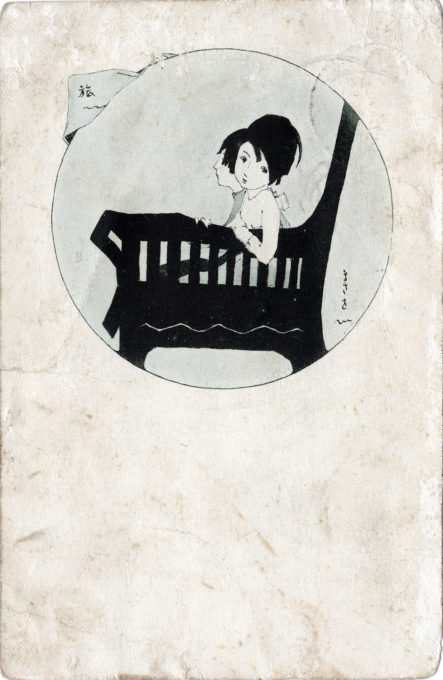See also:
Nakahara Jun’ichi fashion illustrations, c. 1945-1948.
Imatake-designed Takashimaya advertising postcards, 1947.
Across the desert under the moon
Two camels were traveling
With gold and silver saddles on their backs
The two walked side by side.
A prince on the saddle ahead
A princess on the saddle behind
They wore matching white clothes.
Across the wide desert
No one knows where they were going.
– “Under the Desert Moon”, music by Sasaki Suguru, lyrics by Kato Masao
“Kato Masao (haiku pen name, Santei) was an artist known for his romantic drawings and literary works featuring fairies, maidens, children, and flora.
“Originally from Shizuoka prefecture, Kato studied English literature at Rikkyo University, Tokyo. He further studied Western-style painting at the Kawabata Academy of Art (Kawabata ga gakko), becoming one of Japan’s leading lyrical artists of the 1910s-20s.
“It was while Kato was still in school when published his first collection of poetry and paintings, The Canary’s Grave (1920), and started as an illustrator and poet. He mainly drew lyrical illustrations centered on line drawings for girls’ and women’s magazines, capturing their fashions and interests.
“Kato also composed nursery rhymes and published lyrical poetry collections, e.g. Nemu no Cradle (1921) and Masao Jojo Poetry Collection (1926). His novels and short stories were especially popular among young women (Distant Roses [1926], Vanishing Rainbows [1929]). Kato might be best known for a famous children’s song, ‘Under the Desert Moon’, for which he wrote the lyrics in 1923.
“In his youth, he often visited Onjuku Beach in Chiba Prefecture for medical treatment for tuberculosis. A monument honoring Kato and ‘Under the Desert Moon’ was erected on Onjuku Beach, Chiba Prefecture – the beach having served as his lyrical inspiration, with the song lyrics now engraved on plaques lining the seawall separating the beach from Onjuku’s main coastal road.
“Kato himself left a calligraphy in his later years, saying, ‘The moon desert is the sand dunes of Onjuku.’ He moved to Onjuku in 1976, where he died in 1977. Three years before passing, in 1974, Kato wrote and composed the school song for Onjuku Municipal Iwawada Elementary School.
“Fujieda City, Kato’s birthplace in Shizuoka Prefecture also honors its native son. The Fujieda City Folk Museum and Literature Museum displays a collection of his literary achievements.”
– Wikipedia


